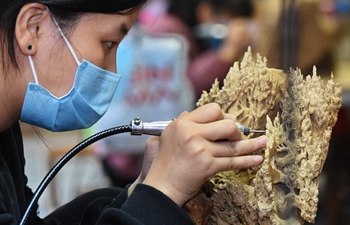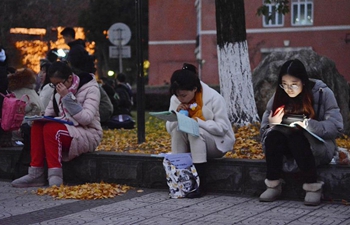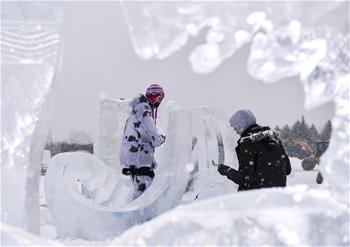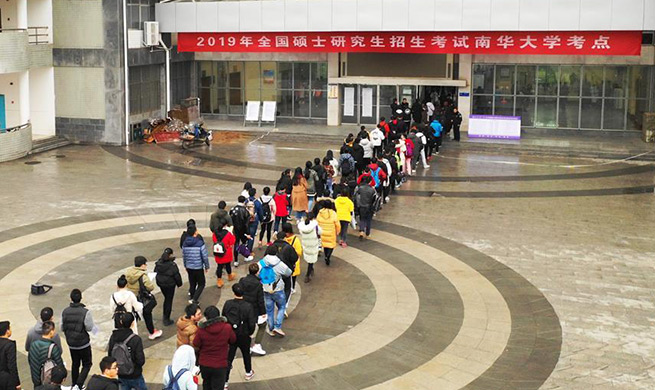by Xinhua writers He Jing, Wu Baoshu
MONTEREY, the United States, Dec. 22 (Xinhua) -- On the corridor walls of Sophia Williams' house hang clusters of pictures of her standing beside her daughter, beaming. Sophia, 55, has been living alone in Monterey, a coastal town in the U.S. state of California, since her daughter moved out five years ago.
Since then, Sophia has been burying herself in her work as a self-employed personal assistant because she has to repay her mortgage and keep the house running.
She works seven days a week and rarely takes time off to visit her daughter in Los Angeles, a city just a few hours' drive away. Like other women in her position, Sophia is determined to rely on herself and be strong.
"I'll not stop working until the day I can't do it. I have to plan for getting older, a thing people of my age are most concerned about," she remarked.
RISING CONCERNS
Sophia is one of the 74 percent of U.S. adults who claim they will continue working in some capacity beyond age 65. This changing attitude toward work, discovered by a Gallup poll earlier this year, reveals rising concerns about health care costs and a cultural shift America has to grapple with as an aging society has become a full-blown reality.
Meanwhile, calls to reform the fragile old-age care system grew even louder before midterm elections as repeated failure to improve its efficiency and reduce health care costs has become a burden not only on the fiscal sustainability of the government, the profitability of firms, but also on the health of millions of people.
Although the Affordable Care Act, also known as Obamacare, has significantly increased the number of Americans with health insurance coverage, 12 percent of adults are still uninsured.
Eighty million people in the United States will be 65 or older within a few decades, compared with around 50 million today. Can the elderly afford their care cost? Is the nation's health care infrastructure close to becoming ready? The answer might be a "no".
Lawmakers across the country have expressed concerns as their constituents' health care burdens continue to rise while cash-strapped retirees try to figure out how to cover their medical bills.
"The biggest fear is not the overall financial situation, it's health costs. Medicare is great, but it only covers 80 percent if you're lucky. And the way Congress acts, nothing is guaranteed," said Bob Lowry, a writer in Arizona.
Roughly 48 million Americans aged 65 or older and another 9 million younger people with disabilities are enrolled in Medicare, a federal health insurance program established in 1965, along with Medicaid and Social Security.
Following their expansion in 1973, the health care system has now grown into the economy's largest sector. Yet, basic Medicare does not cover a variety of health-care expenses including dental work, routine vision and hearing care and long-term care that can severely affect retirees.
INADEQUATE COVERAGE
A Kaiser Family Foundation study released this year shows that the average Medicare beneficiary spent 5,503 U.S. dollars in 2013, including premiums and out-of-pocket costs for covered and uncovered services.
The figure, which has amounted to 41 percent of the average per capita Social Security income, is expected to increase to 50 percent by 2030.
Most seniors, especially those who need long-term care, may even exhaust their savings and then apply for Medicaid as the structure of Medicare requires more out-of-pocket expenditures than health insurance in most of other developed nations.
Jointly funded by the state and federal governments, Medicaid was created as an insurance program for low-income and disabled groups. In California, it was renamed as "Medi-Cal."
Despite several tiers of care services provided for the elderly in California, a large number of them are still facing difficulties, said Ann Flower, a staff member with the Middlebury Institute of International Studies at Monterey.
Ann said her friend's mother, who has been suffering from both Alzheimer's disease and Dementia for years, stays in a care home in San Francisco where her monthly payment might sometimes approximate 11,000 dollars.
Under such circumstance, Medicaid might help if a patient like the mother of Ann's friend is eligible for coverage although requirements for it differ by state.
More than 58 million Americans, about 20 percent of the population, are enrolled in the Medicaid program. Each year, the federal government releases an "official" income level for poverty to determine a citizen's eligibility for Medicaid.
Medicaid covers such expenditures such as prescription, hospitalization, emergency treatment and in-home nurse care, but some physicians do not accept Medi-Cal patients on the grounds of low reimbursement rates and other factors, said Sylvia Willison, analyst with Monterey County Department of Social Services.
Sandi Ellis, senior ombudsman of Alliance of Aging, the largest non-profit provider of senior services in Monterey, the high cost of living is particularly stressful for seniors in the Monterey Peninsula.
Assisted living facilities in the region, according to Ellis, cost from 8,000 to 12,000 dollars a month, a large sum for ordinary families and these facilities only accept private payments. The cost of nursing homes for bed-ridden seniors in need of long-term skilled care is even higher.
"Many seniors have to sell everything within their reach to raise money for this, which is very sad," Ellis said, adding that more low-income housing are in great need in Monterey since the existing ones are already full.
As for Obamacare, also called Covered California in California, Ellis said its premiums are higher than other government-run programs. Some people complained that the program turned out to be different from what it claimed to be.
UNDERAPPRECIATED ISSUE
The Trump administration failed to repeal the Obamacare reform in late 2017 but did manage to eliminate the so-called individual mandate as part of the Tax Cuts and Jobs Act of 2017. The mandate required most Americans to carry a minimum level of health coverage.
"As a beneficiary of Obamacare, I am grateful. However, it's unfair for those who can afford insurance since they are obliged to pay a much higher premium," said Belinda Blake, 61, who was maimed in a car accident in 2015 and has no job. The seven surgeries she underwent were all paid through Obamacare with zero out-of-pocket spending.
"The health care side is where the big concern is for the U.S., and really, it's probably underappreciated in many other countries as well," said Ronald Lee, a demography professor with the University of California, Berkeley. "Right now, Medicare and Medicaid are still relatively modest compared to GDP, but they're going to be increasing fairly rapidly."
A survey conducted by the Commonwealth Fund in 2017 shows that more than 36 percent of U.S. seniors had multiple chronic conditions. Yet, 23 percent of them said they did not visit a doctor when they were sick in the last two years. In other developed countries like Britain, France, Norway and Sweden, only 5 percent or fewer seniors reported skipping needed care due to cost concerns.
America spends 17 percent of its GDP on health care, the highest of any rich country, but the result are the worst among these countries. Health experts propose a stronger social safety net, especially for the high-need elderly -- those with three or more chronic conditions or those who struggle with activities of daily living, to help improve health outcomes and reduce spending.
They also suggest that small steps be taken to restructure the health care system, including bringing down the proportion of the uninsured population, shoring up private insurance market and providing individuals with the choice to either buy Medicare or not.
Sophia said she does not believe any of the existing health care programs is sufficient to cover her future spending. "When I reach 70, one choice could be several old women of similar conditions huddle in one place looking after each other."













